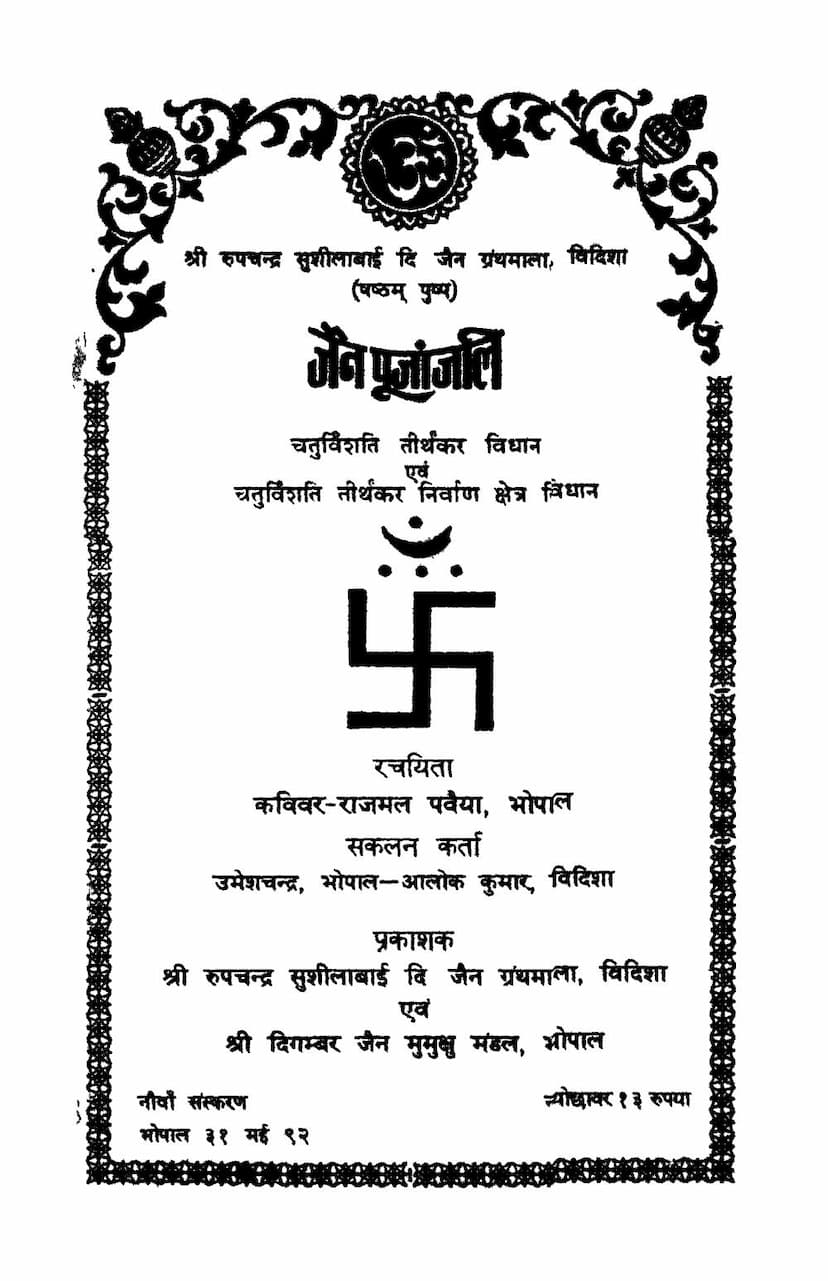Jain Punjanjali
Added to library: September 2, 2025

Summary
The book "Jain Pujanjali" by Rajmal Pavaiya, published by Rupchandra Sushilabai Digambar Jain Granthmala, is a comprehensive collection of Jain devotional hymns and rituals, primarily focusing on the worship of the Tirthankaras. The catalog link provided points to a resource containing various Jain texts, and the pages of "Jain Pujanjali" reveal a structure dedicated to various forms of Jain worship.
Here's a summary of the key aspects and content based on the provided pages:
Core Purpose and Content:
- Devotional Hymns and Rituals: The central theme of the book is Jain worship, offering a variety of "Pujan" (worship) and "Vidhan" (rituals) for different deities and occasions within Jainism.
- Tirthankara Worship: A significant portion of the book is dedicated to the worship of the twenty-four Tirthankaras, the enlightened spiritual guides in Jainism. This includes specific Pujans for individual Tirthankaras and combined rituals like the "Chaturvinshati Tirthankar Vidhan" (Ritual for the Twenty-Four Tirthankaras) and "Chaturvinshati Tirthankar Nirvana Kshetra Vidhan" (Ritual for the Nirvana Sites of the Twenty-Four Tirthankaras).
- Panch-Parameshti Worship: The book also includes Pujans for the Panch-Parameshti (the five supreme beings in Jainism): Arihant, Siddha, Acharya, Upadhyaya, and Sadhu.
- Other Deities and Sacred Sites: Worship for other significant figures like Lord Mahavir, Gautam Swami, Kundakunda Acharya, and the Jain scriptures (Jinavani) are also featured. Pujans for sacred sites like Nandiashwar Island and various "Siddhakshetras" (liberation sites) are included.
- Special Occasion Pujans: The book caters to special festivals and occasions in the Jain calendar, such as "Kshama Vaani" (Forgiveness Day), "Deep Malika" (Festival of Lights), "Rishabh Jayanti" (Rishabhdev's Birthday), "Mahavir Jayanti" (Mahavir's Birthday), "Shrut Panchami" (Veneration of Scriptures), "Raksha Bandhan," and "Veer Shasan Jayanti."
- Methodology and Structure: The book provides detailed rituals, including "Abhishek" (ritual bathing), "Stuti" (praise), hymns, and prayers. The Table of Contents (Page 9 onwards) showcases a vast array of specific Pujans and their corresponding page numbers, indicating a comprehensive and organized approach to devotional practices.
- Author's Contribution: Rajmal Pavaiya is recognized as a prolific composer of devotional songs and rituals within the Jain tradition, known for his ability to imbulate spiritual principles into devotional practices that are accessible to the common devotee. The book highlights his extensive contributions to Jain literature, with over 150 Pujans, 500 Stutis, and numerous other spiritual compositions to his credit.
- Compilation and Publication: The book is a compilation by Umesh Chandra and Alok Kumar, published by Shri Rupchandra Sushilabai Digambar Jain Granthmala, Vidisha. Its multiple editions and wide distribution (over 31,000 copies printed) attest to its popularity and relevance within the Jain community.
- Spiritual Philosophy: The Pujans are described as being infused with the essence of the four "Anuyogas" (modes of discourse in Jain scriptures) - Prathamanuyoga, Charanannuyoga, Karanannuyoga, and Dravyanuyoga. They are not just for outward worship but also encourage introspection and contemplation.
- Support and Sponsorship: The publication of the book is supported by numerous donors and well-wishers, as indicated by the extensive list of names and amounts on pages 4 and 5, signifying community involvement in disseminating Jain knowledge and devotion.
Overall Significance:
"Jain Pujanjali" serves as a vital resource for Jain practitioners, offering a structured and extensive guide to performing devotional rituals and cultivating spiritual devotion. It aims to make complex Jain philosophical concepts accessible through the medium of devotional hymns, fostering a deeper connection with the Tirthankaras and the Jain way of life. The book emphasizes the path to liberation ("Moksha Marg") through these practices.